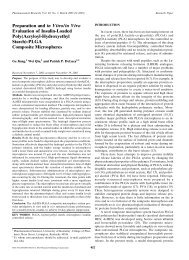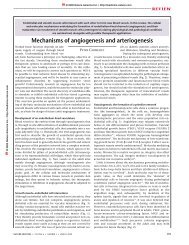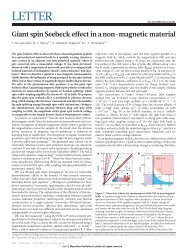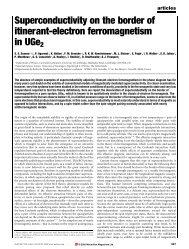The era of carbon allotropes
The era of carbon allotropes
The era of carbon allotropes
You also want an ePaper? Increase the reach of your titles
YUMPU automatically turns print PDFs into web optimized ePapers that Google loves.
commentaryabFigure 4 | Some examples <strong>of</strong> elusive synthetic <strong>carbon</strong> <strong>allotropes</strong>: a, one-dimensional sp-carbyne;b, two-dimensional sp-sp 2 -graphyne; c, three-dimensional sp-sp 3 -yne-diamond.world <strong>of</strong> new endohedral derivatives.<strong>The</strong> substitution <strong>of</strong> <strong>carbon</strong> atoms withheteroatoms such as nitrogen, realized inthe heter<strong>of</strong>ullerene (C 59 N) 2 (Fig. 2e) allowsfor further variation <strong>of</strong> the electronicproperties <strong>of</strong> the fullerene core 19 .nanotubes and graphene<strong>The</strong> electronic and materials properties<strong>of</strong> <strong>carbon</strong> nanotubes and graphene are atleast as remarkable as those <strong>of</strong> fullerenes.Depending on their helicity, <strong>carbon</strong>nanotubes are either semiconducting ormetallic. Both properties are appealingfor applications in the field <strong>of</strong> molecularelectronics or for the refinement <strong>of</strong>materials, such as antistatic paints andshieldings. Indeed, metallic <strong>carbon</strong>nanotubes and graphene are the firstrepresentatives <strong>of</strong> stable organic metalswhere no further activation, dopingor charge transfer is required for theestablishment <strong>of</strong> extremely high chargecarriermobilities. A fascinating recentexample for the performance <strong>of</strong> <strong>carbon</strong>nanotubes is their ability to act as singleelectronpumps 20 . This could be a key forthe development single-electron transistors;devices that can confine charges downto single-electron level and hence, areapplicable for quantized current gen<strong>era</strong>tion.Carbon nanotubes hold the record forthe mechanically strongest material,making them useful for the reinforcement<strong>of</strong> polymers in composite materials. Forexample, coating cotton thread withconductive <strong>carbon</strong> nanotubes leads to theformation <strong>of</strong> a lightweight thread that canbe easily woven into fabrics 21 .Compared with fullerenes, chemicalfunctionalization <strong>of</strong> <strong>carbon</strong> nanotubes iscconsid<strong>era</strong>bly less mature and graphenechemistry is still in its earliest infancy.Nevertheless, graphene-based technologyis at present considered to have thegreatest potential for applications. In thisregard, Nobel Laureate Frank Wilczekfrom the Nobel Symposium on Grapheneheld in May 2010 said: “Graphene isprobably the only system where ideasfrom quantum field theory can leadto potential applications.” <strong>The</strong> idea <strong>of</strong>using graphene for digital electronicswas born in 2004 with the realization <strong>of</strong>a graphene-based field effect transistor 5driven mainly by three extraordinaryproperties: extremely high charge-carriermobilities at room temp<strong>era</strong>ture; anenormous current-carrying capability; andthe fact that graphene is the ultimate thinmaterial. Already it has been shown thatgraphene meets the electrical and opticalrequirements for transparent conductiveelectrodes used in touch screens anddisplays 22 . However, in contrast to thematerial used at the moment, indiumtin oxide, the graphene electrodes areflexible and mechanically more robust. Toproceed with these developments and togain access to mass production, chemicalfunctionalization <strong>of</strong> graphite/graphenecould be a powerful tool to solve a number<strong>of</strong> problems, such as increased solubilityand processability, stabilization in solution,separation and purification, as well asdevice fabrication.elusive <strong>allotropes</strong>During the investigation <strong>of</strong> sp 2 -hybridized<strong>allotropes</strong>, attention has also beenpaid towards the development <strong>of</strong>further synthetic <strong>carbon</strong> <strong>allotropes</strong> 23 .<strong>The</strong> extension <strong>of</strong> the constructionprinciple by incorporating both sp- andsp 3 -hybridized atoms into <strong>carbon</strong> networks<strong>of</strong>fers almost limitless structuralpossibilities. <strong>The</strong> simplest example forsuch synthetic <strong>carbon</strong> <strong>allotropes</strong> isone-dimensional carbyne consisting <strong>of</strong>infinite chains <strong>of</strong> sp-hybridized <strong>carbon</strong>atoms (Fig. 4a). Whereas the parentallotrope itself is still elusive, a number <strong>of</strong>model compounds, namely end-cappedpolyynes, have been synthesizedand characterized.<strong>The</strong> combination <strong>of</strong> sp-, sp 2 - andsp 3 -hybridized <strong>carbon</strong> atoms leads tomany possible two- and three-dimensional<strong>carbon</strong> <strong>allotropes</strong>, such as graphyne 23(Fig. 4b). Significantly large molecularsegments <strong>of</strong> graphyne (pictured in redin Fig. 4b) have been synthesized andtheir study suggests the material hasattractive optoelectronic and self-assemblyproperties. Allotropes with a skeleton<strong>of</strong> sp- and sp 3 -hybridized <strong>carbon</strong> are theleast-studied class <strong>of</strong> hybrid <strong>allotropes</strong>, andthe only notable example reported thus faris expanded cubane 23 . <strong>The</strong> study <strong>of</strong> thesematerials is motivated by the prediction <strong>of</strong>impressive mechanical properties, such ashardness for <strong>allotropes</strong> like yne-diamond,which is composed <strong>of</strong> the hypotheticalbuilding block adamantyne (picturedin red in Fig. 4c). Although a variety<strong>of</strong> low-molecular partial structures <strong>of</strong>these networks have been synthesized,preparative access to these design<strong>era</strong>llotropes is still elusive.ConclusionsSynthetic <strong>carbon</strong> <strong>allotropes</strong> representa growing family <strong>of</strong> fascinating andaesthetically pleasing architectures withoutstanding materials properties. <strong>The</strong>existing representatives, namely fullerenes,<strong>carbon</strong> nanotubes and graphene, willbe complemented in the future bynew <strong>carbon</strong> forms whose constructionprinciples are based on the numerouspossibilities to assemble <strong>carbon</strong> atomsin one, two and three dimensions. Ata time when silicon-based technologyis approaching its fundamental limits,the possible incorporation <strong>of</strong> synthetic<strong>carbon</strong> <strong>allotropes</strong> in the production <strong>of</strong>electronic devices is welcome. As a result<strong>of</strong> their spectacular electronic, thermaland mechanical properties they areexpected to <strong>of</strong>fer an exceptional choice.However, fully realizing their application innanoelectronics, sensors, nanocomposites,batteries and supercapacitors still requiresmuch fundamental research, keepingchemists, physicists, materials scientistsand engineers busy for years to come. ❐870 nature materials | VOL 9 | NOVEMBER 2010 | www.nature.com/naturematerials© 2010Macmillan Publishers Limited. All rights reserved
commentaryAndreas Hirsch is in the Department <strong>of</strong> Chemistryand Pharmacy & Interdisciplinary Center <strong>of</strong>Molecular Materials (ICMM), Friedrich-Alexander-University Erlangen-Nuremberg, Henkestrasse 42,91054 Erlangen, Germany.e-mail: andreas.hirsch@chemie.uni-erlangen.deReferences1. Karfunkel, H. R. & Dressler, T. J. Am. Chem. Soc.114, 2285–2288 (1992).2. Diederich, F. & Rubin, Y. Angew. Chem. Int. Ed.31, 1101–1123 (1992).3. Kroto, H. W. et al. Nature 318, 162–163 (1985).4. Iijima, S. Nature 354, 56–58 (1991).5. Novoselov, K. & Geim, A. et al. Science 306, 666–669 (2004).6. Krätschmer, W. et al. Nature 347, 354–358 (1990).7. Hirsch, A. & Brettreich, M. Fullerenes – Chemistry and Reactions(Wiley, 2004).8. Yang, H. et al. Angew. Chem. Int. Ed. 49, 886 (2010).9. Aoyagi, S. et al. Nature Chem. 2, 678–683 (2010).10. Hirsch, A. & Vostrowsky, O. Top. Curr. Chem.245, 193–237 (2005).11. Dennler, G. et al. Adv. Mater. 21, 1323–1338 (2009).12. Friedman, S. H. et al. J. Am. Chem. Soc. 115 6506–6509 (1993).13. Liu, G-F. et al. Angew. Chem. Int. Ed. 47, 3991–3994 (2008).14. Koudoumas, E. et al. Chem. Eur. J. 9, 1529 (2003).15. Campidelli, S. et al. Chem. Commun. 4282–4284 (2006).16. Holczer, K. et al. Science 252, 1154–1157 (1991).17. Allemand, P. M. et al. Science 253, 301–302 (1991).18. Komatsu, K. et al. Science 307, 238–240 (2005).19. Vostrowsky, O. & Hirsch, A. Chem. Rev. 106, 5191–5207 (2006).20. Siegle, V. et al. Nano Lett. doi:10.1021/nl101023u (2010).21. Shim, B. S. et al. Nano Lett. 8, 4151–4157 (2008).22. Bae, S. et al. Nature Nanotech. 5, 574–578 (2010).23. Diederich, F. & Kivala, M. Adv. Mat. 22, 803–812 (2010).AcknowledgementsA.H. thanks GRAPENOCHEM and the Cluster <strong>of</strong>Excellence EAM for financial support.Green <strong>carbon</strong> as a bridge torenewable energyJames M. Tour, Carter Kittrell and Vicki L. ColvinA green use <strong>of</strong> <strong>carbon</strong>-based resources that minimizes the environmental impact <strong>of</strong> <strong>carbon</strong> fuels couldallow a smooth transition from fossil fuels to a sustainable energy economy.Carbon-based resources (coal, naturalgas and oil) give us most <strong>of</strong> the world’senergy today, but the energy economy<strong>of</strong> the future must necessarily be far morediverse. Energy gen<strong>era</strong>tion through solar,wind and geothermal means is developingnow, but not fast enough to meet ourexpanding global energy needs. We advocatethat ‘green <strong>carbon</strong>’, which enables us to use<strong>carbon</strong>-based sources with high efficiencyand in an environmentally friendly manner,will provide our society time to developalternative energy technologies and marketswithout sacrificing environmental oreconomic quality. Green <strong>carbon</strong> will helpto reduce the loss <strong>of</strong> our precious <strong>carbon</strong>resources, which are better reserved forhigh-value chemicals, and it will ensurethat those hydro<strong>carbon</strong>s used for fuelswill minimize <strong>carbon</strong> emissions. Throughintensive research and development ingreen <strong>carbon</strong>, our society can guarantee anenergy future that uses <strong>carbon</strong> strategically,without smokestacks, greenhouse gases andextensive environmental damage.Building a solid bridge<strong>The</strong>re is a chasm between the diminutiveproportions <strong>of</strong> renewable energy currentlyavailable and our overwhelming dependenceon fossil fuels that currently propel society.<strong>The</strong> energy policy review <strong>of</strong> the Obamaadministration makes this soberinglyclear: “<strong>The</strong> use <strong>of</strong> renewable energy todayand even in the next 5 to 10 years is stillextremely limited when put into thecontext <strong>of</strong> total world use <strong>of</strong> fossil fuels.For example, the world used the equivalent<strong>of</strong> 113,900 t<strong>era</strong>watts hours [TWh] <strong>of</strong> fossilenergy to fuel economic activity, humanmobility, and global telecommunications,among other modern day activities in2007. Replacing those t<strong>era</strong>watts hours withnon-fossil energy would be the equivalent <strong>of</strong>constructing an extra 6,020 nuclear plantsacross the globe or 14 times the number <strong>of</strong>nuclear power plants in the world today.In renewable energy terms, it is 133 timesthe amount <strong>of</strong> solar, wind and geothermalenergy currently in use on the planet.” 1Barring a huge reduction in our globalstandard <strong>of</strong> living, we will need to relyon <strong>carbon</strong>-based energy for some time.Whether this will last for sev<strong>era</strong>l decades orinto the next century is unclear, but whatis apparent is that renewable approachesto energy gen<strong>era</strong>tion are increasing at anannual rate <strong>of</strong> 7.2% compared with 1.6% fornon-renewable growth 2 , and the continuedgrowth <strong>of</strong> renewables will demand sustainedgovernment support. During this transitionwe propose a green <strong>carbon</strong> bridge thatminimizes the environmental impact <strong>of</strong><strong>carbon</strong> fuels and lowers our reliance on theseresources for primary energy gen<strong>era</strong>tion.Ultimately, green <strong>carbon</strong> will use hydrogenfrom renewable sources, while at the sametime producing basic chemical feedstocks.<strong>The</strong> concept <strong>of</strong> a bridge to a renewableenergy future is not new, and many strategieshave been <strong>of</strong>fered as near-term alternativesto conventional <strong>carbon</strong> resources 3 . Althoughsome <strong>of</strong> these concepts appear at first glanceto be ‘green’ solutions, further scrutinythat takes into account the energy lifecycleand environmental consequences suggestsa more murky set <strong>of</strong> trade-<strong>of</strong>fs. Biodiesel,for example, has led to destruction <strong>of</strong> vastareas <strong>of</strong> tropical rainforest to make palmoil 4 . A shift <strong>of</strong> transportation to lithiumbattery-powered cars requires enormousamounts <strong>of</strong> fossil fuels to mine vast stretches<strong>of</strong> the Earth in search <strong>of</strong> lithium, andthe vehicle would need to be driven tens<strong>of</strong> thousands <strong>of</strong> kilometres entirely onrenewable energy just to accrue back the~1.7 GJ energy per kilowatt hour capacityused for the lithium mining and batterymanufacture 5 . <strong>The</strong> electric grid promisedto serve the purportedly clean electric-cartechnology may just become a long tailpipeconnecting the plug-in batteries to coalfiredpower plants 6 . And even if renewableenergies could supply the electricity, thecurrent electrical grids could not sustainthe vast increase in demand. We need toquantify the full environmental or lifecycleconsequences <strong>of</strong> various options for ourenergy bridge if we are to build it from theproper technologies.We must also consider energytechnology options in a broader context. Innature materials | VOL 9 | NOVEMBER 2010 | www.nature.com/naturematerials 871© 2010Macmillan Publishers Limited. All rights reserved







